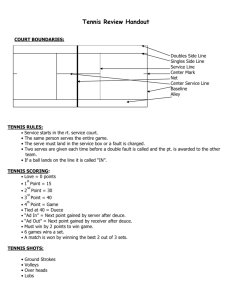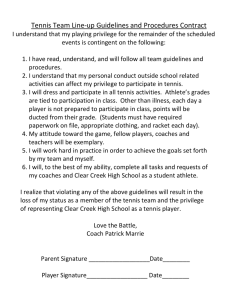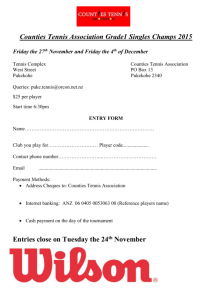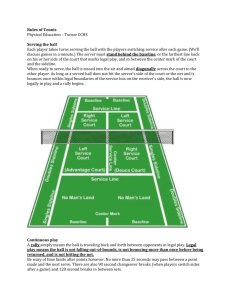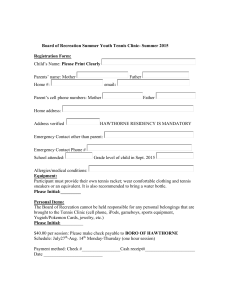Tennis Rules Made Easy
advertisement
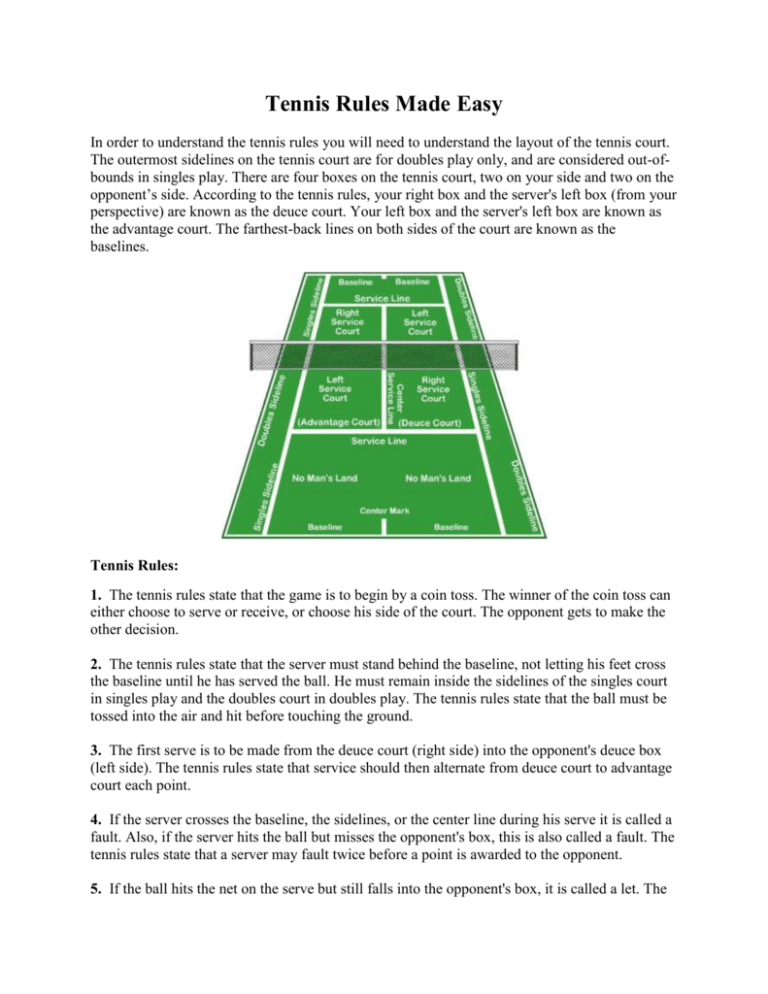
Tennis Rules Made Easy In order to understand the tennis rules you will need to understand the layout of the tennis court. The outermost sidelines on the tennis court are for doubles play only, and are considered out-ofbounds in singles play. There are four boxes on the tennis court, two on your side and two on the opponent’s side. According to the tennis rules, your right box and the server's left box (from your perspective) are known as the deuce court. Your left box and the server's left box are known as the advantage court. The farthest-back lines on both sides of the court are known as the baselines. Tennis Rules: 1. The tennis rules state that the game is to begin by a coin toss. The winner of the coin toss can either choose to serve or receive, or choose his side of the court. The opponent gets to make the other decision. 2. The tennis rules state that the server must stand behind the baseline, not letting his feet cross the baseline until he has served the ball. He must remain inside the sidelines of the singles court in singles play and the doubles court in doubles play. The tennis rules state that the ball must be tossed into the air and hit before touching the ground. 3. The first serve is to be made from the deuce court (right side) into the opponent's deuce box (left side). The tennis rules state that service should then alternate from deuce court to advantage court each point. 4. If the server crosses the baseline, the sidelines, or the center line during his serve it is called a fault. Also, if the server hits the ball but misses the opponent's box, this is also called a fault. The tennis rules state that a server may fault twice before a point is awarded to the opponent. 5. If the ball hits the net on the serve but still falls into the opponent's box, it is called a let. The server is permitted to serve again, and the let does not count as a fault. An unlimited number of lets are permitted. 6. The Tennis rules state that if (on the service) the receiver does not allow the ball to bounce in the box before hitting it, a point is awarded to the server. 7. Once a rally has begun, the players may either allow the ball to bounce once or hit the ball before it has landed at all. If the ball bounces twice on a side however, the tennis rules state that the point goes to the opponent. The point also goes to the opponent if you hit the ball out of bounds or into the net. If the ball hits the net and lands in-bounds, it is considered to be in-play according to the tennis rules. 8. If your body makes contact with the ball, a point is awarded to the opponent. The tennis rules also state that if your body or racket makes contact with the net, a point is awarded to the opponent. 9. A ball that lands on the line is in, and should be played. 10. Service alternates players between games. Tennis Rules of Scoring 1. Scoring in a game goes, for both players, Love-15-30-40. If a player has 40 points and wins another point, he wins the game unless the other player also has 40 points. 2. If both players have 40 points the score is deuce, as a player must win two points to win the game. If both players have at least 40 points and one is winning, the game is said to be his advantage, as another point will win the game for him. 3. A set is won by the first player to win six games, as long as they win by two. If the score is 55, the player may win normally if he gets to 7-5. If the score is 6-6 however, a tiebreaker must be played. 4. A tiebreaker is scored by ones, and the first player to win seven points wins the tiebreaker. The player must still win by two points however. After winning the tiebreaker, the player is awarded the final game, winning the set 7-6. 5. The first player to win two sets wins the match. 6. No-Ad Scoring is an alternative scoring method for winning a game. When using No-Ad scoring, the players call the points, 1, 2, 3, and 4. A game is won when a player or team wins 4 points. If the score reaches 3-3, the player or team does not have to win two more points--there is no "deuce-ad" situation. At 3-3, the receiver tells the server into which service court the serve must be served.
